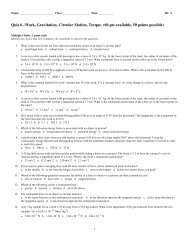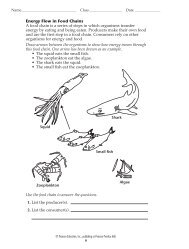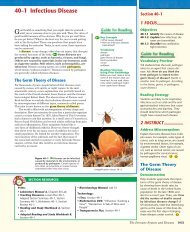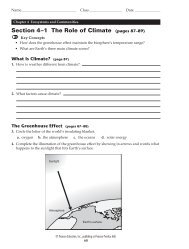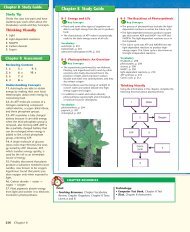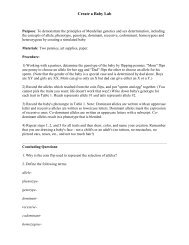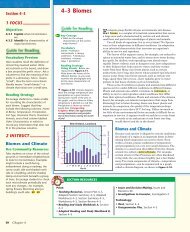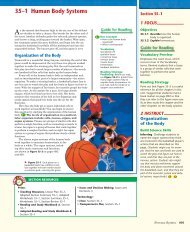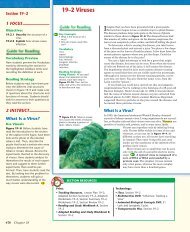Unit 1 Assessment - Downtown Magnets High School
Unit 1 Assessment - Downtown Magnets High School
Unit 1 Assessment - Downtown Magnets High School
You also want an ePaper? Increase the reach of your titles
YUMPU automatically turns print PDFs into web optimized ePapers that Google loves.
Chemistry AB<strong>Unit</strong> 1 Summative Cumulative <strong>Assessment</strong>Write an essay that explains how the physical and chemical behavior of elements can bepredicted based on their location on the periodic table and describes the structure of the atombased on the element's location in the periodic table. (In completing this assignment, you willbe addressing the Chemistry California State Standards on Atomic and Molecular Structure.)Rubric:An “A” paper will elucidate the key concepts in the unit. Key terms will bedefined/explained, with examples. An “A” paper will show a thoroughness of breadthand depth, without inappropriate repetition. Ideas will be clearly stated with highfidelity to scientific correctness. An “A” paper will exemplify good writing skills interms of organization, grammar, sentence structure and spelling.A “B” paper will cover most but not all of the key concepts in the unit. Examples willdemonstrate a substantial amount of understanding even though the explanation of keyconcepts and terms is incomplete. Science ideas will be predominantly correct, withminor errors in understanding. A “B” paper will show strong, but imperfect, attentionto writing skills in terms of organization, grammar, sentence structure and spelling.Spelling errors will be confined to words that are outside of the key concepts in theunit.A “C” paper will make a significant but incomplete effort at dealing with unit concepts.Key ideas are correctly explained with examples but supporting detail is weak. Clarityof expression is a “work-in-progress”, with islands of writing that require the reader toimport outside meaning to make sense out of the student work. The writing showssignificant misunderstandings, which show that the student falls short of masteringthe purpose of the unit. Writing skills show weakness in organization, grammar,spelling and sentence structure to the point that the clarity of the writing iscompromised by the writing skills.A “D” paper lists a few relevant pieces of information with little support ororganization. Details are lacking and the student has serious misunderstandings aboutscience concepts, strays off-topic much of the time, or fills up space with repetitionthat achieves little breadth or depth. A “D” paper shows poor writing skills, with littleattention paid to grammar, spelling or sentence structure.An “F” paper does not demonstrate any significant ability to relate the ideas andconcepts of the unit.On the back side is an example of what an A paper might look like.
Atomic and Molecular StructureThe modern Periodic Table arranges atoms by increasing atomic number rather than by atomic mass.Atoms are made up a nucleus containing most of the most of the atom's mass but occupying very little of theatom's volume. The number of protons in an atom is always equal to the element's atomic number. Thenumber of neutrons is equal to the atomic mass minus the atomic number. In the nucleus are positive protonsand neutral neutrons held together by nuclear forces. The Bohr model of the atom pictures negative electronsoutside the nucleus, traveling in circular paths called orbits. When viewed from the Wave Mechanical model ofthe atom, electrons occupy regions in three-dimensional space called orbitals. Orbitals are not paths but simplyregions where electrons are likely to be found. For neutral atoms, the number of electrons is equal to thenumber of protons.The right side of the Periodic Table is divided by a zig-zag line that originates to the left of the elementBoron and ends up between the elements Polonium and Astatine. Elements to the left and below this zig-zagline are known as metals while those above and to the right of the zig-zag lines are known as non-metals. Thesix elements boron, silicon, germanium, arsenic, antimony and tellurium are known as semi-metals (ormetalloids or semi-conductors). The metals are malleable, ductile, have luster, high tensile strength and aregood conductors of heat and electricity. By contrast, non-metals are brittle, non-lustrous, have low tensilestrength and are good insulators of heat and electricity. Semi-metals are intermediate in physical propertiesbetween metals and non-metals.Electronegativity measures how much one atom wants to take electrons from other atoms. Elements withhigh electronegativity are extremely electron-hungry while those with low electronegativity are not particularlyelectron-hungry. Fluorine is the element with the highest electronegativity, and with the exception helium andneon, fluorine can take electrons from any other element.Ionization energy measures how strongly an atom hangs onto the electrons it already has. Elements withhigh ionization energy would fight to keep their electrons while elements with low ionization energies wouldsurrender an electron very easily. Helium has the highest ionization energy, and shows the most resistance tolosing its electrons.Metals have low electronegativity and high ionization energy. Therefore metals ionize to become cationswith a positive charge. Group 1 elements (known as alkali metals) ionize to form cations with a charge of +1 bylosing a single electron. Group 2 elements (known as alkaline earth metals) to form cations with a charge of +2by losing two electrons. Aluminum (in group 13) ionizes to form a cation with a charge of +3, by losing threeelectrons.Non-metals have high electronegativity and low ionization energy. Therefore non-metals ionize to becomeanions with a negative charge. Group 17 elements (known as halogens) ionize to form anions with a charge of–1 by gaining a single electron. Non-metals in group 16 ionize to form anions with a charge of –2 by gainingtwo electrons. Non-metals in group 15 ionize to form anions with a charge of –3 by gaining three electrons.Carbon (in group 14) sometimes ionizes to from an anion with charge of –4 by gaining four electrons.Periodic trends predict patterns of behavior based on the location of elements on the Periodic Table. Forexample, atomic size decreases as we go from left to right across a row (period) because the increasing numberof protons pulls in the electrons more tightly, making the atom smaller. Atomic size increases as we go down acolumn (group or family) because we are adding more orbits as we go down a column.In going across a row of the Periodic Table, ionic size depends on the "Jenny Craig" rule: the moreelectrons the atom has lost, the smaller it is; the more electrons an atom has gained, the bigger it is. So cationslike Al +3 are smallest because they have lost the most electrons. And anions like C -4 are biggest because theyhave gained the most electrons. Ionic size increases as we go down a column because again we are addingorbits.Both ionization energy and electronegativity increase as we go from left to right across the Periodic Table.However, small group 18 elements (noble gases) have no electronegativity since they neither want to gain norlose electrons. Both ionization energy and electronegativity decrease as we go down a column of the PeriodicTable.Valence (electrons available for chemical bonding) is determined by group number. For Main groupelements to the left of the transition elements (groups 3 – 12), the valence number is equal to the groupnumber. For elements to the right of the transition elements, the valence number is determined bysubtracting 10 from the group number.



